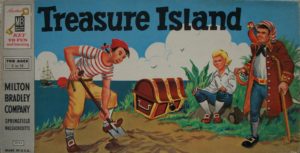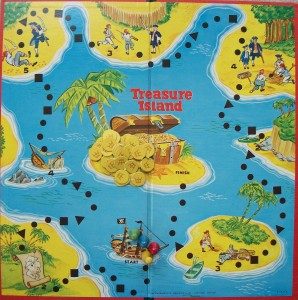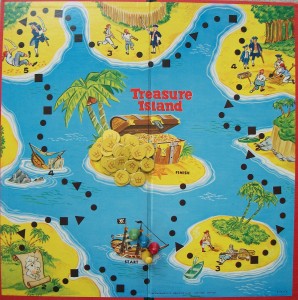
Treasure Island is a timeless and classic adventure story published in 1883 and written by Robert Louis Stevenson. It takes readers on an exciting journey to find hidden treasure. In 1956, Milton Bradley brought this adventurous story to the game table by producing a game of the same name: Treasure Island. Players were then able to act out the search for gold by the spin of wheel.
Game play is for 2 to 4 players, ages 5 and up. It’s a simple race game where players are told in the directions that each player represents Jim Hawkins as he attempts to find the most pirate treasure.
The old game board highlights various scenes and is a nice collectible board to display next to the book, Treasure Island. To play, players begin on the Pirate Ship space which is just off shore and they follow ‘black spots’, squares, and triangles around the board according to their spins on the wheel. The objective of the game is to be the player to accumulate the most ‘pieces of eight’ during play and by the end of the game.
Setup requires placing ‘pieces of eight’ (small circular gold disks made from cardboard) on the Treasure Chest game space in the center of the board. Players next pick a colored pawn to move around the board. Play begins with the spin of the wheel.

Depending on which spaces a player lands on, determines whether he receives a ‘pieces of eight’ or possibly loses a ‘pieces of eight’. Landing on a Square space, he receives. Landing on a Triangle space, he loses; or he may choose to remain on the space until he spins a 5 or 6. If he does choose to stay, and spins a 5 or 6, he may move on without having to return a ‘pieces of eight’ to the Treasure Chest in center.
No matter the spin of a player, he must stop on the numbered images on the board. Some of these spaces show Pirate Fights, Sunken Ships, Digging for Treasures, or even the X Marks the Spot Map.
While here he chooses to give up one of his pieces of eight to move on quickly on his next turn, or again, he may choose to stay and try to spin a number greater or the same as the numbered image he is currently on and keep his pieces of eight treasures.
For example, if he was on numbered image 5 with the pirates fighting in the top left corner, he would have to spin a 5 or 6 to move on without giving up a pieces of eight. If he was on numbered image 3 in the bottom right corner of the board, he would have to spin a 3, 4, ,5 or 6 to move on.
The player who arrives at finish first receives 10 extra pieces of eight. Second to finish receives 6, and the 3rd player to arrive receives 3. Game play ends when the next to last player reaches the Treasure Chest.
At this time players tally up their gold and the player with the most wins!
Although simple, and basically a game of pure chance, players can enjoy playing by imagining themselves as truly out looking for gold. It might also inspire the reading of the story Treasure Island or maybe players will make their own treasure map and challenge others to find their hidden treasure.
Whatever the choice, playing a game can always be fun. It’s a great collectors item.
Play a game, any game, today!

